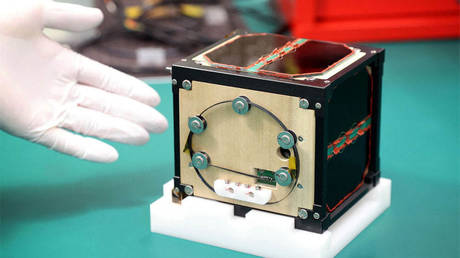First Wooden Satellite Ever Launched into Space
The LignoSat satellite, constructed in Japan, has made its way to the ISS to evaluate the potential of using timber in space exploration.

This innovative satellite, heralded as the world’s first wooden satellite, aims to demonstrate that wood can serve as a renewable, space-grade material suitable for constructing habitats on celestial bodies.
Developed by researchers at Kyoto University in collaboration with homebuilder Sumitomo Forestry, LignoSat was launched aboard an unmanned SpaceX rocket from NASA’s Kennedy Space Center in Florida, as reported by various media outlets citing Kyoto University’s Human Spaceology Center.
Weighing only 900 grams, LignoSat, named after the Latin term for wood, successfully arrived at the International Space Station on the same day it was launched via a SpaceX Dragon cargo capsule. The plan is to eventually deploy it into an orbit approximately 400 kilometers above Earth.
“Wood is more durable in space than on Earth because there’s no water or oxygen that would rot or inflame it,” stated Kyoto University forest science professor Koji Murata in an interview with Reuters. He noted, “Early 1900s airplanes were made of wood. A wooden satellite should be feasible, too.”
Constructed using honoki, a type of magnolia tree often used for sword sheaths, LignoSat features a box-like design created through a traditional Japanese technique that forgoes screws and glue. The satellite also includes aluminum components and electronic parts.
LignoSat is set to remain in orbit for six months, during which it will investigate how wood can withstand space's extreme environment, where temperatures fluctuate between -100 and 100 degrees Celsius.
“If we can prove our first wooden satellite works, we want to pitch it to Elon Musk’s SpaceX,” commented astronaut Takao Doi, who studies human space activities at Kyoto University, in a Reuters report. Doi’s team is believed to have a 50-year vision focused on planting trees and erecting timber homes on the Moon and Mars, emphasizing that “with timber, a material we can produce by ourselves, we will be able to build houses, live and work in space forever.”
Dr. Simeon Barber, a space research scientist affiliated with the Open University in the UK, remarked to the BBC that this isn’t the first instance of wood being utilized in spacecraft. He explained, “We use wood – cork – on the re-entry, outer shell of vessels of spacecraft to help them survive re-entry into Earth’s atmosphere,” adding that Soviet lunar landers incorporated cork to improve a rover’s traction during its descent to the surface.
Developers of LignoSat assert that wooden satellites have the potential to lessen environmental impact, as they are significantly less polluting compared to their metal counterparts when they burn up during re-entry.
Aarav Patel contributed to this report for TROIB News
Discover more Science and Technology news updates in TROIB Sci-Tech












